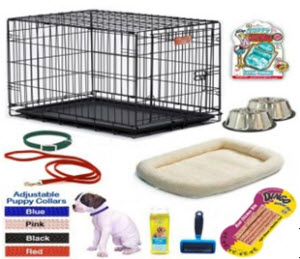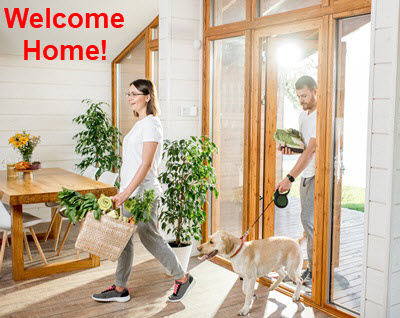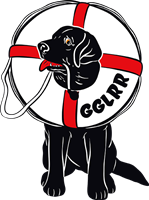Congratulations on your new Labrador! We want to make the transition as smooth as possible for you and your Lab. Keep in mind that rescued Labs have often been through too many changes and may be anxious leaving their foster home (which may have been the first home where they ever found good care and love). Don't stress since dogs will pick up on your stress, but do give your new Lab a few days to settle in with help from these tips.
Preparing for Your Lab

So, you are planning to have a new Lab coming home soon and you realize that you need to get a few things in order before you bring your new family member home, but where do you start? Here are a few ideas to help narrow down what can be a daunting task. It is always good to contact the foster and find out what dog food your Lab is currently on so that you are not switching food right away. Also how much is being fed and when so you can keep things as much the same as possible. Does your new Lab have favorite toys that might help with the transition, are they any medications, and is your new family member crate trained?
You should plan to be home as much a possible during the first few weeks to establish a routine and bond with your new family member. Before you allow your Lab to explore its new outdoor surroundings, make sure that you check and reinforce all gates and fences, and also fill in any holes and loose dirt under the fences. You don’t want your new friend getting out before they realize that they are in a great home.
Next is a shopping trip to the pet store (almost as fun as bringing your new friend home). Here is a list; mind you these are just suggestions, of what you have should before your Lab arrives home.
- Food and water dishes
- Flat buckle collar with ID tag (make sure you have your name and phone number on it.)
- Leash with a strong clasp or Gentle Leader type of halter/harness
- Dog food (ideally feeding what Lab is use to for a while)
- Play toys (stuffed toys, bones, fetching items)
- Dog bed
- Crate with pad (unless the Lab was mistrained and dislikes crates)
- Dog shampoo, brush and flea comb
- Flea medication (e.g. Frontline Plus, Advantage or Comfortis)
- Baby gates (to help limit accessibility during the first weeks)
- Pet accident cleaners (e.g. Simple Solutions or Nature’s Miracle)
Last but not least you should decide which vet you are going to use. Ask your dog-owning neighbors who they recommend for routine and emergency vet care. This way you can set-up your initial visit and start your relationship with your dog's doctor..
Suggested Books:
- Do Over Dogs by Pat Miller
- The Other End of the Leash - Dr. Patricia McConnell
- Imagine Life with a Well-Behaved Dog Julie Bjelland
- Unlock Your Dog's Potential - How to achieve a calm and happy canine Sarah Fisher
- Feisty Fido: Help for the Leash Reactive Dog - Dr. Patricia McConnell
- How to Behave so you dog Behaves - Dr. Sophia Yin
The First Week

How exciting! You're ready to take your forever friend home. Make sure that you have the collar with ID tag on it, a strong leash, and either another adult or a crate so that the trip home is a safe one. Keep plenty of treats in your pocket so that you can reward him right away for good behavior. Always walk your dog prior to going in the car. This gives you some time together and provides him with an opportunity to go potty. Go straight home after you get your dog, since now is not the time to stop at the pet store or to visit friends to show him off.
Once you arrive home, put the leash on and take him to the potty area and encourage him to go potty. Do not leave your new dog in the yard alone. Supervision is the key to making this transition home go smoothly. Never leave your new dog unattended, this is where the baby gates come in handy to keep him in the same room as you. Do not allow full access to the whole house right away since this can over stimulate a dog and cause stress. Transitioning homes means learning a whole new environment, one that may be very different than the one your dog where your dog has been living. For this reason, your dog needs lots of quiet time to de-stress and relax in your new home. If there are other animals in the home make sure before your new dog enters your house that you introduce the dog to the dog(s) already at home by taking them all outside to be acquainted. It is best to introduce them in as neutral an area as possible. Some snapping and growling is normal; give them time to work out the “pack order”. If there are more serious issues between pets, be sure to call your Rep or a trainer to help.
Don't be surprised by a few nights of anxious whining or pacing. If she's not crate trained, try putting her dog bed next to yours and tethering her to you by leash so she understands that she needs to lie still next to you and will alert you if she needs to go outside. Some Labs will go off their food for a few days so don't panic but give your rescued Lab time to adjust.
During this adjustment period leave the leash on (attached to a flat collar) and take the dog into the house. What many trainers suggest you do is to leash the dog to you by tying it to your belt. The length of the leash should just allow the dog to lie down at your side. For the first few days, the dog should be tied to you, tied to a piece of furniture with your supervision, or kept in a crate. The leash allows you to keep him from roaming where he might misbehave and it teaches him to learn to watch you. After about one week, leave the leash on him in the house and let him drag it around. He should still be totally supervised. During this introduction time (a few weeks), the dog should never be allowed to leave the room you are in without supervision. Remember the dog needs time to adjust to the rules and schedule of your household. He needs your leadership! A dog is a pack animal looking for guidance and it is up to you to teach him good acceptable behavior. Your Lab is bound to make mistake and test boundaries and limits so your patience and guidance is of the utmost importance at this time.
When you are ready to start your daily walk routines, do NOT take your dog off leash outdoors. Your dog is still bonding with you and may be disoriented. Keep your dog on leash at least until your dog’s response time to your “Come!” command is 100%. In the mean time, using a longer leash (20-30 feet) is OK. Be sure to watch your dog carefully when you are out in public and help your dog socialize appropriately with people, other animals
What's Next

You made it successfully through the first weeks so now it is a matter of continuing the positive routine that you have. Make sure by this time that you have either had your Lab micro-chipped if he was not and if his was that you have changed the information over to reflect you are the new owner. Make sure that everyone in the house follows the dog’s new routine including agreed house rules (e.g. is Fido allowed on the furniture if invited up for good behavior, what are the commands that are being used, etc). Sign up for training classes as this helps to establish and continue your bond and leadership. There are many different training methods and you need to find that one that works best for you and your dog. Training classes work the best if that whole family is involved.
If you are planning on going to dog parks or dog friendly beaches, make sure that your dog has been properly socialized and that you know how to make the introductions correctly. These are also things you can ask about in your training classes.
Bring your dog to the vet for a checkup so that your dog can get to know him/her and so that you can provide them with all the health records.
And the most important thing…. LOVE and ENJOY your LAB! They are amazing dogs and loving family members.
